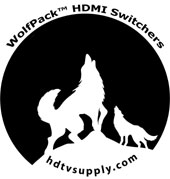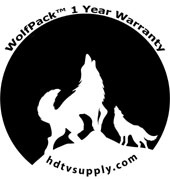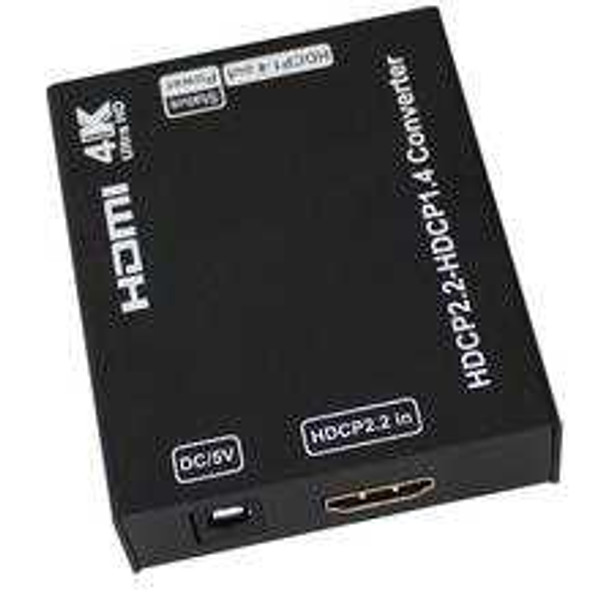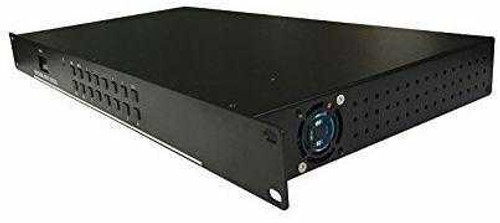
If you ever saw the following statement: "This TV does not support HDCP 2.2. Make sure you have an HDCP 2.2 capable TV or a similar HDCP error message." Make sure you never see it again with HDTV Supplys HDCP 2.2 to HDCP 1.4 Converter. Upgrade to perfect HDCP 2.2 for a fraction of the cost of buying a new display!
Our WolfPack HDCP 2.2 to HDCP 1.4 Converter is the best for playback of new 4K HDCP 2.2 encoded content on 4K displays with the older HDCP 1.4 standard. Most 4K televisions sold in the last few years do not support HDCP 2.2, but our WolfPack HDCP 2.2 to HDCP 1.4 Converter allows 4K video to be vividly seen. Our WolfPack HDCP 2.2 to HDCP 1.4 Converter is also a great compatibility solution for AV distribution systems running a mix of new and old 4K displays.
The unit supports up to HDMI 2.0 at 10.2 GBPS products. HDTV Supplys WolfPack HDCP 2.2 converter converts an HDCP 2.2 compliant signal to HDCP 1.4. You can connect the converter with HDCP 1.4 devices to make sure the HDCP 2.2 source be displayed on HDCP 1.4 4K displays. Our HDCP 2.2 converter is a device that sits between a 4K source and the non-HDCP 2.2 display to allow protected 4K content to pass through to the UHD display and supports HDMI 2.0 and all past versions.
HDCP 2.2 is the new copy-protection scheme for 4K UHD content. Not only is it not backward compatible but many recent 4K devices do not even support it. Source devices, including media servers and head-ends like Netflix, will encode their 4K content with this new scheme. TVs must be HDCP 2.2-enabled to play it, and everything in the video chain including switches and receivers must be compliant as well, or the display will go dark and/or display a HDCP error message.
This is bad news for consumers who have purchased expensive, high-bandwidth, processor-rich switchers and receivers to accommodate 4K and only our HDCP 2.2 to HDCP 1.4 converter can help you with your existing system.
WolfPack HDCP 2.2 to HDCP 1.4 Converter Features:
- 4K Apple TV
- 4K Amazon Fire
- 4K Sony PS4 PRO
- 4K Xbox One S
- 4K TiVo Bolt
- Sony, Panasonic, Samsung, OPPO & Philips 4K UHD DVD Players
- All 4K Roku Media Players
- 4K DirecTV Genie receivers
- 4K Dish Hopper receivers
- 4K Sony FMP-X10 UHD players
- 4K NVidia Shield UHD Netflix devices
- 4K Surround Sound AV Receivers
- 4K Video Cards
- and more 4K HD HDCP 2.2 devices
- Supports HDMI 2.0 and all past versions
- HDMI input: HDCP 2.2
- HDMI output: HDCP 1.4
- Video Format Supported: DTV/HDTV:480i/576i/480P/576P/720P/1080i/1080P/4Kx2K 3D video support
- Maximum video Format: 4Kx2K@60Hz, YUV 4:2:0 and YCBCR 4:2:0)
- 18 GBP/sec speed
- Supports DTS-HD Master Audio, Dolby True-HD and LPCM
- Supports 3D and CEC
- DC 5V 1A power supply
- Operating Temperature Range -5 to +35鈩(+23 to +95鈩)
- Operating Humidity Range 5 to 90%RH (No Condensation)
- 1-HDMI input (Standard Type A connector)
- 1-HDMI output (Standard Type A connector)
- Supports Video Color Format of xv-YCC/deep color 36bit
- Supports Audio Format DTS-HD Master Audio, Dolby true-HD and LPCM
- Power consumption: 1.5 watts(Maximum)
Why not buy this HDCP 2.2 Adapter today?
WolfPack HDCP 1.4 Converter Contents:
- 1 - HDCP 2.2 to 1.4 HDMI Converter
- 1 - 5V 1A DC Adapter
- 1 - User Manual
Our WolfPack HDCP 2.2 to HDCP 1.4 Converter allows you to view HDCP 2.2 content from your Sony 4K media player, your Shield game console, your graphics cards, your Blu-ray player, satellite/cable or via Netflix or internet sources on all standard 50/60Hz or 100/120Hz HDMI or DVI-D displays without HDCP2.2 compliant input!
HDCP 2.2 is the new copy-protection scheme for 4K UHD content. Not only it is not backward compatible but many recent 4K devices dont even support it. Source devices, including media servers and head-ends like Netflix, will encode their 4K content with this new scheme. TVs must be HDCP 2.2-enabled to play it, and everything in the video chain including switches and receivers must be compliant as well, or the display will go dark and/or display a HDCP error.
This is bad news for consumers who have purchased expensive, high-bandwidth, processor-rich switchers and receivers to accommodate 4K. While the newer products may support the bandwidth needs of 4K, they wont play copy-protected works until HDTV Supplys HDCP 2.2 to HDCP 1.4 Converter is an active part of the setup.
Why not buy this HDCP 2.2 Adapter today?
HDCP stands for "High-bandwidth Digital Content Protection". HDCP requires that each HDMI connection establish a unique link between the two devices, often called a handshake. This "handshake" trades encrypted codes between the devices so that you can't plug your Blu-ray player into a recorder and rip a copy. Many of the problems that we hear people having with their HDMI devices comes from this handshake failing.
HDCP 2.2 is all about protecting 4k content. That means if you want to stick with 1080p for the time being, you don't have to worry about HDCP 2.2. If you do want 4k content, every device in your video chain must have HDCP 2.2. This will be true in the future where content will be HDCP 2.2 encrypted. Non-2.2 encrypted content will not apply.
The problem we've seen is that people are assuming that anything with HDMI 2.0 will have HDCP 2.2. So far, that has not been the case. Our research has shown that there are no devices currently offered that have both a full HDMI 2.0 implementation and HDCP 2.2.
Right now, if you've bought (or are thinking of buying) a new receiver from the likes of Denon, Marantz, and Yamaha, you may see HDMI 2.0 on the specification sheet. This is a full 18Gbps HDMI 2.0 port meaning you can realize all the additional benefits of HDMI 2.0. But they don't have HDCP 2.2 so future content may or may not be limited.
On the flip side, new Onkyo receivers are listed with HDCP 2.2. What they aren't telling you is that the HDMI 2.0 implementation is limited to 10.2Gbps (just like HDMI 1.4). While this allows the Onkyo receiver to pass the HDCP 2.2 handshake, it will limit how much data can be passed, negating many of the benefits of HDMI 2.0. If the device does NOT show HDCP 2.2 compatibility, when native 4k content arrives, your device will not accept it.
If you are shopping for a 4k display, you'll want to look for HDCP 2.2 compatibility as well as resolution and bit depth or use our HDCP 2.2 to HDCP 1.4 Converter. Match the display's capabilities with the HDMI 2.0 maximums, and you should be good to go. If the display does NOT show HDCP 2.2 compatibility, when native 4k content arrives, your display will not accept it.
On receivers, you'll want to check how many of their inputs/outputs are HDMI 2.0 and HDCP 2.2 enabled. Right now, manufacturers are limiting the maximum number to decrease costs. With limited bandwidth on some HDMI 2.0 terminals and lack of HDCP 2.2 on others, you may have to send video directly from your Blu-ray player to your display (bypassing your receiver) if you buy one of the first generation HDMI 2.0 receivers
Why not buy this HDCP 2.2 Adapter today?
DirecTV Controller
WolfPack HDCP 1.4 Converter Compatibility:
- Roku 4 media player
- 4K DirecTV Genie receivers
- 4K Sony FMP-X10 UHD players
- 4K NVidia Shield UHD Netflix devices
- 4K Amazon Fire Players
- 4K Surround Sound AV Receivers
- and more 4K HD HDCP 2.2 devices
Bad news for consumers who have purchased expensive, high-bandwidth, processor-rich switchers and receivers to accommodate 4K. While the newer products may support the bandwidth needs of 4K, they won't play copy-protected works until Integral is an active part of the setup. HDTV Supplys HDCP 2.2 converter solves all these problems.
Why not buy this HDCP 1.4 Adapter today?
A: 06/11/2018 - FROM A CUSTOMER: I raised a ticket to Nvidia and I also figured out it is Netflix app issue.
https://forums.geforce.com/default/topic/1025676/experience-6-means-i-can-no-longer-watch-netflix-in-4k-24
So, 4K 24 or 4K 30 is no longer working with Netflix app on Nvidia shield with latest sw update. Amazon 4K is working fine.
Q: Why do you need HDCP 2.2 to HDCP 1.4 Converter?
A: HDCP 2.2 is the new copy-protection scheme for 4K UHD content. Not only it is not backward compatible but many recent 4K devices do not even support it.
Source devices, including media servers and head-ends like Netflix, will encode their 4K content with this new scheme(HDCP 2.2). TVs must be HDCP 2.2-enabled to play it and everything in the video chain including switches and receivers must be compliant as well, or the display will go dark and/or display a HDCP error.
Customers may have purchased expensive,high-bandwidth switchers and receivers with HDCP 1.4,so they will need HDCP 2.2 to HDCP 1.4 Converter to make sure the HDCP 2.2 source can be displayed on the HDCP 1.4 displays.
Q: Will the WolfPack HDCP 2.2 to HDCP 1.4 converter work with the Samsung LU28D590DS/ZA 4K computer monitor connected to a Amazon Fire TV, Roku 4, Nvidia Shield, etc.? Will I be able to watch 4K (UHD) movies/TV shows on Netflix and Amazon Prime using this converter between the Samsung 4K monitor and the above streaming devices?
A: Yes, we have the same TV and devices in our lab and it works
Q: I'm having an issue with my Sony TV, can you help?
A: Try these:
- Try another HDMI port on the TV or...
- Select "4K" for resolution on the Roku settings page,
- Turn off the TV and the Roku,
- Unplug the Roku from the HDMI port and plug it back into port 1,
- Turn the Roku on first - then turn on the TV
Q: Do HDMI 2.0 cables need to be used?
A: Yes, see HDMI 2.0 cables.
Q: I have a 4K TV, but it's not a DIRECTV Ready 4K TV. Can I still enjoy DIRECTV 4K movies?
A: Yes, as long as the TV is a compatible 4K model that supports a minimum of 60 frames per second, and is equipped with both HDMI 2.0 and HDCP 2.2 ports. See more at 4K DirecTV Tips.
Q: This WolfPack HDCP 2.2 to HDCP 1.4 converter has CEC, what is CEC?
A: This product features CEC (Consumer Electronics Control) allowing your HDTV's remote to manage up to ten devices that are connected via HDMI (such as Blu-ray Disc players or home theater receivers) with no special programming needed. For example, you can use your remote to turn on your TV, your player, and your receiver at the same time, and adjust the system volume with one button. All devices must support CEC, though.
Most major TV manufacturers now support CEC, and an HDTV with HDMI 1.3 will likely have the technology. Manufacturers call it by different names; LG Electronics, for instance, calls its implementation SimpleLink, whereas Toshiba calls its version CE-Link. Interoperability isn't mandatory, so some manufacturers limit control to their own products; Sony, for one, allows only Sony-to-Sony communication.
Why not buy this HDCP 2.2 to HDCP 1.4 converter today?
 HDTV Supply includes a 1 Year Limited U.S. Warranty on this WolfPack HDCP 2.2 to HDCP 1.4 converter. The U.S. warranty states that (a) its 1080p to 4K HDMI Scaler will perform substantially in accordance with the accompanying written materials for a period of 1 year from the date of receipt & (b) that the HDCP 2.2 to HDCP 1.4 converter will be free from defects in materials & workmanship under normal use & service for a period of 1 year. In order to get a warranty replacement for a defective item, HDTV Supplys Support Team will verify the HDCP 2.2 to HDCP 1.4 converter is eligible for warranty. An RMA number will then be issued. Shipped HDCP 2.2 to HDCP 1.4 converters will be in like new conditions, tested & all components included. A 30-day RETURN also comes with this warranty as well as Free Lifetime Tech Support.
HDTV Supply also sells a 3 and 5 Year Extended U.S. Warranty for this HDCP 2.2 to HDCP 1.4 converter. Please go to Extended Warranties or see the above Options to purchase it.
HDTV Supply includes a 1 Year Limited U.S. Warranty on this WolfPack HDCP 2.2 to HDCP 1.4 converter. The U.S. warranty states that (a) its 1080p to 4K HDMI Scaler will perform substantially in accordance with the accompanying written materials for a period of 1 year from the date of receipt & (b) that the HDCP 2.2 to HDCP 1.4 converter will be free from defects in materials & workmanship under normal use & service for a period of 1 year. In order to get a warranty replacement for a defective item, HDTV Supplys Support Team will verify the HDCP 2.2 to HDCP 1.4 converter is eligible for warranty. An RMA number will then be issued. Shipped HDCP 2.2 to HDCP 1.4 converters will be in like new conditions, tested & all components included. A 30-day RETURN also comes with this warranty as well as Free Lifetime Tech Support.
HDTV Supply also sells a 3 and 5 Year Extended U.S. Warranty for this HDCP 2.2 to HDCP 1.4 converter. Please go to Extended Warranties or see the above Options to purchase it.










